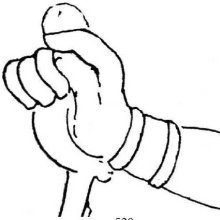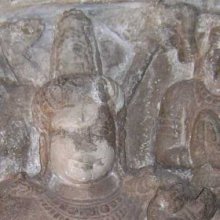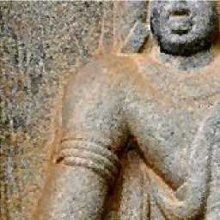Prakoshtha, Prakoṣṭha: 15 definitions
Introduction:
Prakoshtha means something in Hinduism, Sanskrit, the history of ancient India, Hindi. If you want to know the exact meaning, history, etymology or English translation of this term then check out the descriptions on this page. Add your comment or reference to a book if you want to contribute to this summary article.
The Sanskrit term Prakoṣṭha can be transliterated into English as Prakostha or Prakoshtha, using the IAST transliteration scheme (?).
Alternative spellings of this word include Prakoshth.
Images (photo gallery)
In Hinduism
Purana and Itihasa (epic history)
Source: archive.org: Shiva Purana - English TranslationPrakoṣṭha (प्रकोष्ठ) refers to the “wrist”, according to the Śivapurāṇa 2.2.40.—Accordingly, as Brahmā narrated to Nārada:—“[...] after going beyond Alakā, the capital of the king of Yakṣas and the Saugandhika park, they saw the fig-tree of Śiva. [...] Beneath that vaṭa of yogic potentialities, Viṣṇu and other Devas saw Śiva seated. [...] He had put his left leg over his right thigh and knee. The Rudrākṣa garland was suspended from his wrist (i.e., bāhu-prakoṣṭha). He was showing the Tarkamudrā (with his hand)”.

The Purana (पुराण, purāṇas) refers to Sanskrit literature preserving ancient India’s vast cultural history, including historical legends, religious ceremonies, various arts and sciences. The eighteen mahapuranas total over 400,000 shlokas (metrical couplets) and date to at least several centuries BCE.
Vaishnavism (Vaishava dharma)
Source: Pure Bhakti: Brhad BhagavatamrtamPrakoṣṭha (प्रकोष्ठ) refers to:—Chamber; section; area. (cf. Glossary page from Śrī Bṛhad-bhāgavatāmṛta).

Vaishnava (वैष्णव, vaiṣṇava) or vaishnavism (vaiṣṇavism) represents a tradition of Hinduism worshipping Vishnu as the supreme Lord. Similar to the Shaktism and Shaivism traditions, Vaishnavism also developed as an individual movement, famous for its exposition of the dashavatara (‘ten avatars of Vishnu’).
Ayurveda (science of life)
Source: gurumukhi.ru: Ayurveda glossary of termsPrakoṣṭha (प्रकोष्ठ):—[prakoṣṭhaḥ] (1) Forearm. Antebrachium. (2) distal third of the forearm. The portion of the arm between the elbow and the wrist.

Āyurveda (आयुर्वेद, ayurveda) is a branch of Indian science dealing with medicine, herbalism, taxology, anatomy, surgery, alchemy and related topics. Traditional practice of Āyurveda in ancient India dates back to at least the first millenium BC. Literature is commonly written in Sanskrit using various poetic metres.
India history and geography
Source: Singhi Jain Series: Ratnaprabha-suri’s Kuvalayamala-katha (history)Prakoṣṭha (प्रकोष्ठ) refers to a “royal palace”, according to “A Cultural note on the Kuvalayamala of Uddyotanasuri” by the late Dr. V. s. Agrawala.—Page 185.21 f.: Here follows a description of two printed scrolls, one illustrating the Jaina conception of saṃsāracakra and the other of Bhavāntaras. The saṃsāracakra was also painted by Buddhists on a ceiling at Ajanta. It is stated in Divyāvadāna that Bhavacakra was painted in the dvāra-prakoṣṭha or the entrance of the royal palace. It is little surprising that the different parts of the painting were explained by being pointed out with a long stick. The saṃsāracakra illustrated the three worlds of hell, human world and the world of gods.

The history of India traces the identification of countries, villages, towns and other regions of India, as well as mythology, zoology, royal dynasties, rulers, tribes, local festivities and traditions and regional languages. Ancient India enjoyed religious freedom and encourages the path of Dharma, a concept common to Buddhism, Hinduism, and Jainism.
Languages of India and abroad
Sanskrit dictionary
Source: DDSA: The practical Sanskrit-English dictionaryPrakoṣṭha (प्रकोष्ठ).—
1) The fore-arm, the part above the wrist; वामप्रकोष्ठार्पितहेमवेत्रः (vāmaprakoṣṭhārpitahemavetraḥ) Kumārasambhava 3.41; कनकवलयभ्रंशरिक्तप्रकोष्ठः (kanakavalayabhraṃśariktaprakoṣṭhaḥ) Meghadūta 2; R.3.59; Ś.6.6; कनकवलयभूषितप्रकोष्ठैः (kanakavalayabhūṣitaprakoṣṭhaiḥ) Bu. Ch.5.81.
2) The room near the gate of a palace; Mu.1.
3) A court in a house, a quadrangle or square (surrounded by buildings); इमं प्रथमं प्रकोष्ठं प्रविशत्वार्यः (imaṃ prathamaṃ prakoṣṭhaṃ praviśatvāryaḥ) &c. Mṛcchakaṭika 4.
4) A part of a door-frame.
Derivable forms: prakoṣṭhaḥ (प्रकोष्ठः).
Source: Cologne Digital Sanskrit Dictionaries: Shabda-Sagara Sanskrit-English DictionaryPrakoṣṭha (प्रकोष्ठ).—m.
(-ṣṭhaḥ) 1. The fore-arm. 2. Part of the frame of a door. 3. A court in the house, or open space surrounded by buildings. 4. A room near the gate of a Palace. E. pra before, kuṣ to draw, sthan aff.
Source: Cologne Digital Sanskrit Dictionaries: Benfey Sanskrit-English DictionaryPrakoṣṭha (प्रकोष्ठ).—[pra-koṣṭha], m. 1. The fore-arm, [Śākuntala, (ed. Böhtlingk.)] [distich] 133. 2. and ºṭa + ka, The room near the gate of a palace, [Kumārasaṃbhava, (ed. Stenzler.)] 15, 6.
Source: Cologne Digital Sanskrit Dictionaries: Cappeller Sanskrit-English DictionaryPrakoṣṭha (प्रकोष्ठ).—[masculine] fore-arm; a room near the gate (or a court*) of a royal palace.
Source: Cologne Digital Sanskrit Dictionaries: Monier-Williams Sanskrit-English Dictionary1) Prakoṣṭha (प्रकोष्ठ):—[=pra-koṣṭha] m. the fore-arm, [Kālidāsa; Bhāgavata-purāṇa; Suśruta]
2) [v.s. ...] a room near the gate of a palace, [Mudrārākṣasa]
3) [v.s. ...] (also n., [cf. Lexicographers, esp. such as amarasiṃha, halāyudha, hemacandra, etc.]) a court in a house, a quadrangle or square surrounded by buildings, [Mṛcchakaṭikā]
4) [v.s. ...] a part of a door-frame, [Horace H. Wilson]
Source: Cologne Digital Sanskrit Dictionaries: Yates Sanskrit-English DictionaryPrakoṣṭha (प्रकोष्ठ):—[pra-koṣṭha] (ṣṭhaḥ) 1. m. The fore-arm; part of the frame of a door; open court-yard of a house.
Source: DDSA: Paia-sadda-mahannavo; a comprehensive Prakrit Hindi dictionary (S)Prakoṣṭha (प्रकोष्ठ) in the Sanskrit language is related to the Prakrit word: Pauṭṭa.
[Sanskrit to German]
Sanskrit, also spelled संस्कृतम् (saṃskṛtam), is an ancient language of India commonly seen as the grandmother of the Indo-European language family (even English!). Closely allied with Prakrit and Pali, Sanskrit is more exhaustive in both grammar and terms and has the most extensive collection of literature in the world, greatly surpassing its sister-languages Greek and Latin.
Hindi dictionary
Source: DDSA: A practical Hindi-English dictionaryPrakoṣṭha (प्रकोष्ठ) [Also spelled prakoshth]:—(nm) wrist; courtyard; chamber.
...
Kannada-English dictionary
Source: Alar: Kannada-English corpusPrakōṣṭha (ಪ್ರಕೋಷ್ಠ):—
1) [noun] the part of the arm between the elbow and the wrist; the forearm.
2) [noun] an area surrounded by buildings on all the side; a yard; a quadrangle.
Kannada is a Dravidian language (as opposed to the Indo-European language family) mainly spoken in the southwestern region of India.
See also (Relevant definitions)
Partial matches: Koshtha, Pra, Koshta.
Starts with: Prakoshthaka.
Ends with: Dvaraprakoshtha.
Full-text: Pautta, Prakoshthaka, Prakoshth, Praveshta, Vahirdvaraprakoshthaka, Pakuta, Bhavacakra, Samsaracakra, Kaksha.
Relevant text
Search found 5 books and stories containing Prakoshtha, Pra-koshtha, Pra-koṣṭha, Pra-kostha, Prakoṣṭha, Prakostha, Prakōṣṭha; (plurals include: Prakoshthas, koshthas, koṣṭhas, kosthas, Prakoṣṭhas, Prakosthas, Prakōṣṭhas). You can also click to the full overview containing English textual excerpts. Below are direct links for the most relevant articles:
Brihad Bhagavatamrita (commentary) (by Śrī Śrīmad Bhaktivedānta Nārāyana Gosvāmī Mahārāja)
Verse 2.4.253 < [Chapter 4 - Vaikuṇṭha (the spiritual world)]
Verse 1.6.63 < [Chapter 6 - Priyatama (the most beloved devotees)]
Verse 2.4.152 < [Chapter 4 - Vaikuṇṭha (the spiritual world)]
Pallava period (Social and Cultural History) (by S. Krishnamurthy)
Shoulder and Arm Ornaments (Bhujabhushana) (Introduction) < [Chapter 4 - Material Culture of the People]
Bracelets (a): Separate bangles around each wrist < [Chapter 4 - Material Culture of the People]
Conclusion (Material Culture) < [Chapter 5 - Conclusion]
The Skanda Purana (by G. V. Tagare)
Chapter 22 - Indradyumna Goes to Brahmā’s Abode along with Nārada < [Section 2 - Puruṣottama-kṣetra-māhātmya]
Manasara (English translation) (by Prasanna Kumar Acharya)
Natyashastra (English) (by Bharata-muni)


